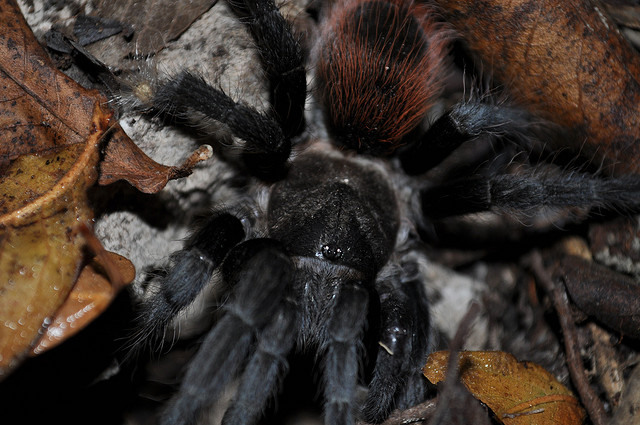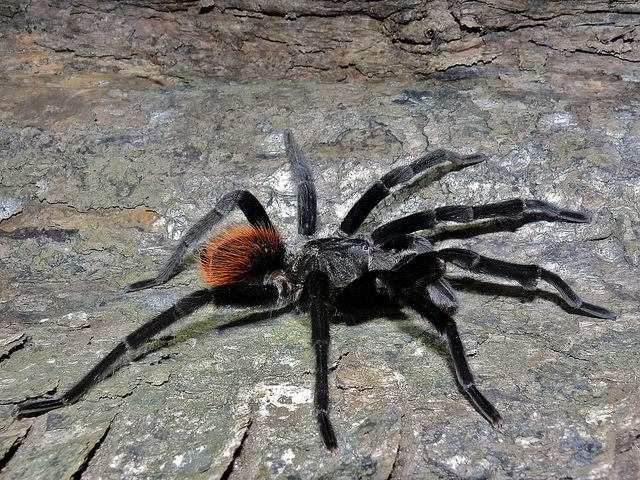Adaptation
Let’s take a look at a few of the adaptations that these
tarantulas have made in order to succeed and thrive in their
environments!
 Like all
members of the phylum Arthropoda, Brachypelma vagans are Ecdysozoans,
meaning they molt (Dor-2012). This adaptation allows B. vagans to shed
their outer layer of skin, making room for further growth and
better protection. This may take anywhere from 2-12 hours.
During this time, B. vagans lay on their back and break free
from their old exoskeleton. Following this process, the Mexican
Red Rump Tarantula will typically avoid any interactions to
deter from possible damage to their fragile, soft, newly formed
exoskeleton. This usually means hiding in their burrow for a few
hours, giving their new exoskeleton time to harden for optimal
protection.
Like all
members of the phylum Arthropoda, Brachypelma vagans are Ecdysozoans,
meaning they molt (Dor-2012). This adaptation allows B. vagans to shed
their outer layer of skin, making room for further growth and
better protection. This may take anywhere from 2-12 hours.
During this time, B. vagans lay on their back and break free
from their old exoskeleton. Following this process, the Mexican
Red Rump Tarantula will typically avoid any interactions to
deter from possible damage to their fragile, soft, newly formed
exoskeleton. This usually means hiding in their burrow for a few
hours, giving their new exoskeleton time to harden for optimal
protection.
Another
adaptation that these quick, skittish spiders have made is a
defense mechanism that a few other tarantulas possess also. When
threatened by possible predators, B. vagans will kick these
special urticating hairs off their back and onto their attacker
(Edwards-2013).
When these hairs come in contact with skin, eyes, or are
inhaled, it presents a burning sensation that is harmful to the
predator, scaring it off. This adaptation has allowed B. vagans,
along with many other tarantulas, to not only survive, but
thrive in their environments.
There
are three main types of urticating hairs. The type the B. vagans
and most other spider possesses is a true seta hair (Battisti et
al. 2010). These hairs are designed to be removed easily since
they have lost a neurological connection and are only held in by
a thin layer of cells called Integument (Battisti et al. 2010).
The B. vagans does not always have these hairs however, the B.
vagans only gets these hairs after it reaches maturity and
leaves the parents nest (Battisti et al. 2010).
These organisms also have fangs, called chelicerae, located
under the eyes. The chelicerae have the ability to release
poisonous venom into prey to kill it. Once the B. vagans attacks
it’s prey with it’s quick, stealthy hunting technique, the
tarantula with dig the fangs into the prey and release the venom
into the organism. Although this venom will kill most of the
prey, it is essentially harmless to humans. This is another
reason why these spiders are ideal for domestic keepings.
Another advantageous feature that the Mexican Red Rump Tarantula
possesses are the pedipalps. These are located on the foremost
part of the spider, slightly ahead of the front legs. Pedipalps
are chemical detectors, allowing the B. vagans to smell and
taste it’s food. These sensitive detectors are also used to
carry sperm to the female during mating. This adaptation has
allowed the B. vagans to survive the threats from potential
mates, who try to kill off their male sperm providers.
To continue to the Reproduction page, click here.